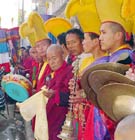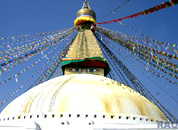|
Lhosar
, the New Year festival of the Sherpa communities |
 |
The
Sherpa communities celebrate Lhosar, the greatest festival of Sherpas and
other people belonging to Tibeto-Burmese communities. There are altogether
250,000 Sherpas scattered in different countries like Bhutan, India, Tibet,
Nepal and other countries. In 2002 the Sherpas are celebrating the
Tibetan New Year 2129 which is also called Water Horse Year. The tradition
to celebrate Lhosar dates back to the time of Tibetan King Nagshi
Chambo. In 2002 the Year of Serpant turned into the Year of Water Horse. |
According
to the Chinese astrological system there exists a cycle of twelve years
named after different animals such as mouse, bull/cow, tiger, rabbit/cat,
dragon/divine eagle, serpent, water horse, sheep, monkey, hen, dog and
pig.
The
Tibetan Buddhist or the Tibeto-Burmease communities celebrate three types
of Lhosar - Tola (Tamu), Sonam and Gyalbo Lhosar. While the Tamu Lhosar
is celebrated by the Gurungs, Sonam Lhosar is celebrated a of the Gyalbo
Lhosar mainly by the peasant communities.
The
festival has a single purpose: welcome the new year. It is also celebrated
in the Tibetan Autonomous Region and China, Japan, Mongolia, Taiwan and
other East Asian countries.
There
is a need for some research so that the exact date and time of the festival
can be found out. Bhairab dances were performed depicting the removing
of bad spirits in the year gone by. The Chayama dance has a religious symbol,
which means to destroy and wash away the ill character of yesterdays and
welcoming the good fortune of all. The pujas and all the dances were not
performed for one single person but for all humanity.
 |
In
Nepal, thousands of Sherpa and also the Tibetan refugees are bracing up
for the festival of Chhimar, Khapsa and Dichhyang. In Boudhanath , Sherpa
men and women, dressed in their traditional, and colourful costumes, called
bakhhu, are gathering at Sherpa monastery to celebrate their New
Year festival, 'Lhosar'. Lhosar is one of the greatest festivals celebrated
by welcoming good days ahead and washing away the ill omens of yesterday. |
In
the run-up to the festival, they clean up their houses as they bid adieu
to the miseries of the past year. All this to welcome happier days ahead.
And they say to each other - "Tashi Delek!" They call the upcoming Lhosar
or the New Year - Gyalbo Lho-Sar, which literally means kingly new year
As
Lhosar comes right on their doors, new Buddhist prayer flags and Lungtas
are being put up in the houses, stupas and monasteries. There are still
around 32,000 Tibetan refugees living in Nepal. The 15-day long celebrations
reach its peak when the Sherpas, the Tamangs and the Tibetan communities
gather at their houses and monasteries. They perform pujas during the festival,
which is basically the time to eat delicacies and wear new clothes. Visiting
friends and relatives, they receive blessings from elders and extend their
best wishes to all. They literally forget everything in the world, such
as monetary and other business transactions, except their near and dear
ones.
On
the first day of Lhosar, Sherpas stay at home and celebrate with their
family members. It is believed that it is not good to go out of the house
on the first day. On the second day Sherpa people start visiting friends
and relatives' houses and greet each other 'Tashi delek'. Thousands of
Sherpas gather at the Sherpa monastery and exchanged their hearty new year
wishes, dancing, drinking and merry making the pure Sherpa way. They exchange
their best wishes with all Sherpa families residing within the valley.
Everyone entering the monastery is welcomed by traditional ghee tea and
a few steps ahead, Sherpas are happy sprinkling chimar (mixture of wheat
flour, sugar and ghee) on their shoulders, which mean to welcome the good
days ahead.
| more
information |
 |
|





